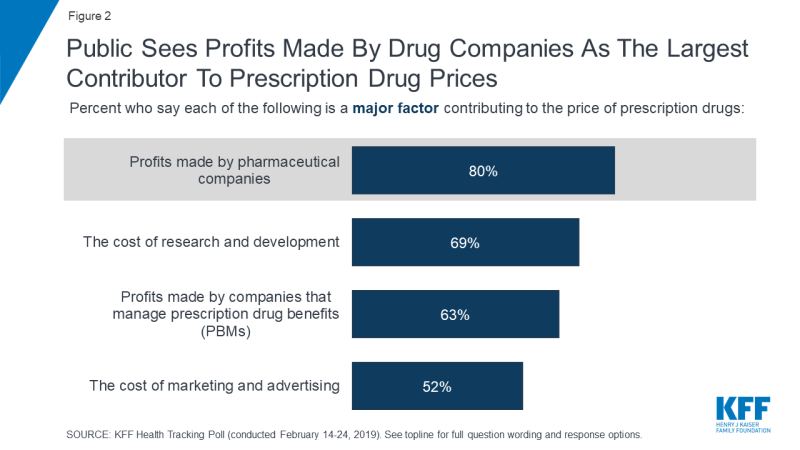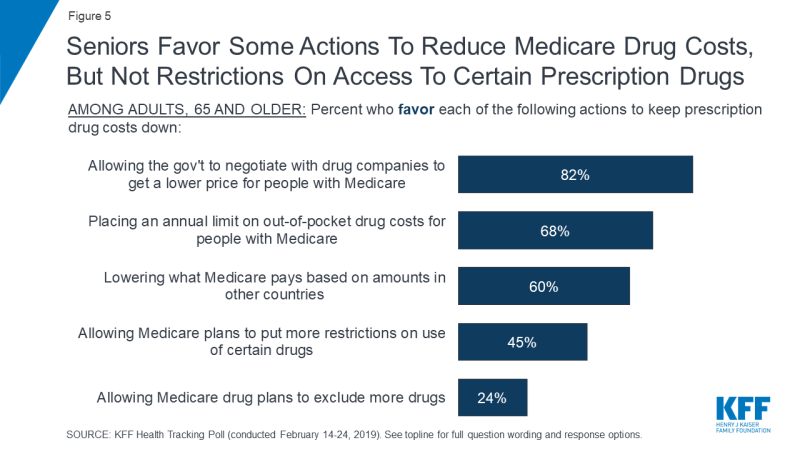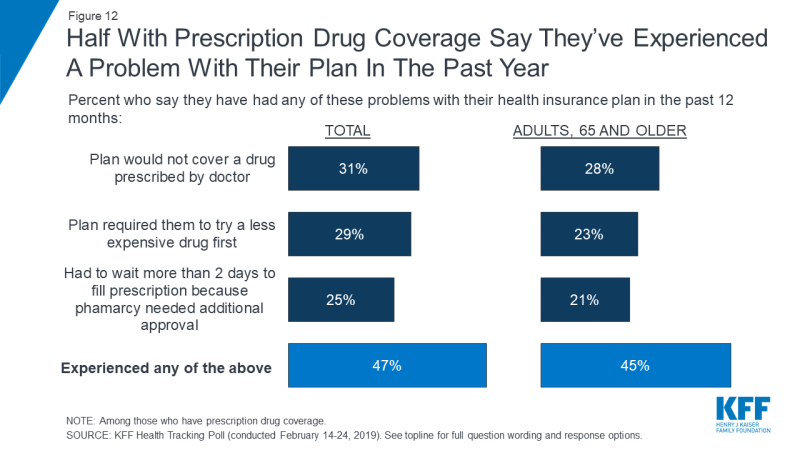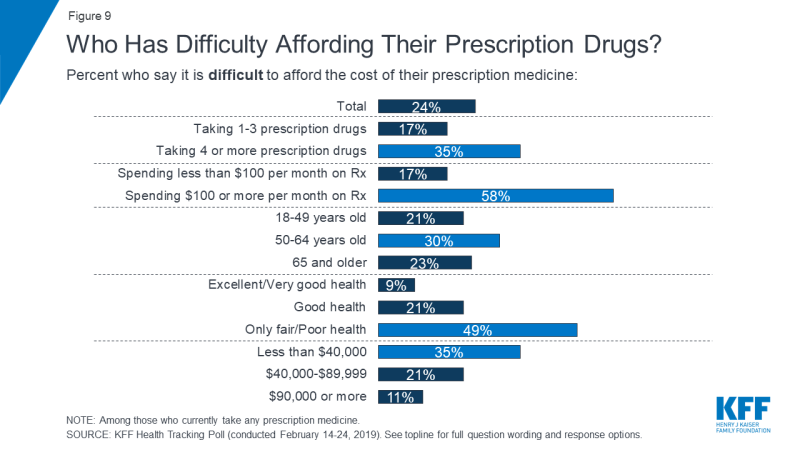KFF Health Tracking Poll – February 2019: Prescription Drugs
Key Findings:
- With increased attention among policymakers towards prescription drug costs, the February 2019 KFF Health Tracking Poll finds a majority of adults, including seniors, are in favor of many policy options aimed at curbing prescription drug costs. There is majority support – across party identification – for many current policy proposals, including recent Trump administration proposals like international reference pricing and transparency in drug advertisements. Both of these policy proposals are supported by large majorities of Democrats and independents, and a majority of Republicans.
- There is also bipartisan support for allowing the federal government to negotiate with drug companies to get a lower price for people with Medicare, which covers 60 million Americans. But attitudes towards this proposal shift after hearing potential arguments about how it might affect some people with Medicare.
- Among those currently taking prescription drugs, one-fourth of adults (24 percent) and seniors (23 percent) say it is difficult to afford their prescription drugs including about one in ten (overall and among seniors) saying it is “very difficult.” Certain groups are much more likely to report difficulty affording medication, including those who are spending $100 or more a month on their prescriptions (58 percent), those who report being in fair or poor health (49 percent), those who take four or more prescription drugs (35 percent), and those with incomes less than $40,000 annually (35 percent). In addition, three in ten of all adults (29 percent) report not taking their medicines as prescribed at some point in the past year because of the cost and one in ten (8 percent) say their condition got worse as a result of not taking their prescription as recommended.
- While the public sees profits made by pharmaceutical companies as a major factor contributing to the price of prescription drugs (80 percent), a majority (63 percent) also say profits made by pharmacy benefit managers (PBMs), companies that manage prescription drug benefits for health plans, are a “major factor” contributing to the price of prescription drugs.
- This month’s KFF Health Tracking Poll also tracks public opinion on the Affordable Care Act and the proposal to expand coverage through a national health plan, known commonly as Medicare-for-all and finds favorability towards both the ACA (50 percent) and Medicare-for-all (57 percent) statistically unchanged since last month.
Public Views Prescription Drug Costs As Unreasonable, Wants More Government Regulation
A majority of Americans (59 percent) believe prescription drugs developed over the past 20 years have generally made the lives of people in the U.S. better – with nearly four in ten saying they have made people’s lives “a lot better.” Yet, eight in ten (79 percent) say the cost of prescription drugs is “unreasonable.”

Figure 1: While A Majority Of Adults Say Prescription Drugs Have Made Lives Better, Most Say The Cost Is Unreasonable
The public sees profits made by pharmaceutical companies as a major factor contributing to the price of prescription drugs. At least eight in ten – across party identification – say profits made by pharmaceutical companies are a “major factor” in the price of prescription drugs. This is followed by seven in ten (69 percent) who say the cost of research and development is a “major factor” contributing to the price.

Figure 2: Public Sees Profits Made By Drug Companies As The Largest Contributor To Prescription Drug Prices
The Trump administration proposed a new rule earlier this month affecting pharmacy benefit managers (PBMs), companies that manage prescription drug benefits for health plans. About six in ten (63 percent) of the public say profits made by these companies (PBMs) are a “major factor” contributing to the price of prescription drugs. About half (52 percent) say the cost of marketing and advertising is a major factor in prescription drug prices.
Public Does Not Trust Drug COmpanies To Price their products fairly
Majorities of the public trust pharmaceutical companies (either “a lot” or “somewhat”) to be good stewards in terms of developing new effective drugs (71 percent), and offering reliable information to consumers about drug safety and side effects (65 percent) as well as drug efficacy (61 percent). About half trust pharmaceutical companies to inform the public quickly when they learn of a safety concern with their drugs (47 percent) and even fewer trust pharmaceutical companies to price their products fairly (25 percent). This is a significant decrease from 41 percent who said they trusted pharmaceutical companies to price their products fairly back in 2008.

Figure 3: Most Trust Drug Companies On Variety Of Issues, But Few Trust Drug Companies To Price Their Products Fairly
Bipartisan Support for Some Government Regulation on Prescription Drug Prices
Prescription drug costs have been a focus of lawmakers, with hearings held in both the House and Senate, and numerous proposals put forward by the Trump administration and members of Congress. This is consistent with the public’s priorities as the January 2019 KFF Health Tracking Poll found lowering prescription drug costs remains a priority for the public with majorities of Democrats, independents, and Republicans saying this was important for Congress to work on.
The majority of the public is in favor of most current policy options aimed at helping keep the cost of prescription drugs down included in this month’s survey.
The vast majority of Americans favor requiring drug companies to include drug list prices in their advertisements (88 percent)1, making it easier for generic drugs to come to market (88 percent), and allowing the federal government to negotiate with drug companies to get a lower price on medications for people with Medicare (86 percent). All three of these policy proposals are supported by large majorities of Democrats, independents, and Republicans.
Most Americans are aware that people in this country often pay higher prices for prescription drugs than people in other countries such as Canada and Western Europe and a majority favor two proposals aimed at leveling international prices. Eight in ten favor allowing Americans to buy drugs imported from licensed Canadian pharmacies while two-thirds (65 percent) favor lowering what Medicare pays based on amounts paid in other countries where governments more closely control prices. Both of these proposals garner bipartisan support.
| Table 1: Favorability Towards Prescription Drug Policy Proposals By Party Identification | |||
| Percent who favor each of the following actions to keep prescription drug costs down: | Democrats | Independents | Republicans |
| Requiring drug companies to include list prices in ads | 90% | 89% | 90% |
| Making it easier for generic drugs to come to market | 89 | 88 | 85 |
| Allowing the gov’t to negotiate with drug companies to get a lower price for people with Medicare | 90 | 87 | 80 |
| Allowing Americans to buy drugs imported from Canada | 78 | 79 | 76 |
| Placing an annual limit on out-of-pocket drug costs for people with Medicare | 80 | 72 | 75 |
| Lowering what Medicare pays based on amounts in other countries | 74 | 62 | 54 |
| Increasing taxes on drug companies whose prices are too high | 73 | 64 | 48 |
| Ending the tax break given to drug companies for their advertising spending | 54 | 62 | 55 |
| Allowing Medicare plans to put more restrictions on use of certain drugs | 59 | 55 | 44 |
| Allowing Medicare drug plans to exclude more drugs | 28 | 22 | 26 |
| Note: Some items asked of separate half-samples. | |||
Majorities of the public favor placing an annual limit on out-of-pocket prescription drug spending for seniors with Medicare (76 percent). Fewer – but still a slight majority (53 percent) – favor allowing Medicare plans to put more restrictions on the use of certain drugs, like making patients try cheaper alternatives before taking a more expensive drug. Only a quarter favor allowing Medicare plans to exclude more drugs in order to keep prices down, a recent proposal from the Trump Administration.2
Seniors’ views of Prescription Drug Policy Proposals
This month’s KFF Health Tracking Poll includes a deep dive into the experiences and attitudes of senior adults, 65 and older, who are more likely to report taking prescription medication and have typically had to shop for prescription drug coverage in addition to their Medicare coverage.
Adults, 65 and older, and Prescription Drug Coverage
Prescription drug coverage plays an important role in health care for many adults, 65 and older (“seniors”), and younger beneficiaries with long-term disabilities, and accounts for nearly one-fifth of all Medicare spending. Nearly three-fourths of all Medicare beneficiaries (72 percent) have prescription drug coverage through Medicare Part D, which is administered by both private stand-alone plans and Medicare Advantage drug plans. With an aging population, the February KFF Health Tracking Poll includes an over-sample of adults, 65 and older, in order to better understand how those most directly affected by prescription drug policy view proposed changes.
See more at: 10 Essential Facts About Medicare and Prescription Drug Spending
These results do not differ when looking specifically at the opinion of those who would be directly affected by changes to Medicare prescription drug coverage. A majority of seniors also favor allowing the federal government to negotiate with drug companies to get lower prices for people with Medicare (82 percent), placing an annual limit on out-of-pocket spending for people with Medicare (68 percent), and lowering what Medicare pays based on amounts paid by other countries where governments more closely control prices (60 percent). Fewer favor allowing Medicare plans to put more restrictions on the use of certain drugs (45 percent) or allowing Medicare plans to exclude more drugs (24 percent).

Figure 5: Seniors Favor Some Actions To Reduce Medicare Drug Costs, But Not Restrictions On Access To Certain Prescription Drugs
Public Opinion on Federal Government Negotiating on Medicare Drug Costs
Overall, about four in ten of all adults and seniors are aware the federal government does not currently negotiate with drug companies in order to get lower prices on prescription drugs for people with Medicare. A policy proposal that has been around for years, this idea has gained traction in recent months, with several members of Congress proposing various approaches to allow Medicare to negotiate drug prices. Overall, nearly nine in ten Americans (86 percent) favor allowing this type of negotiation, however, attitudes shift after hearing potential arguments that have been made both in favor and against the proposal. For example, support for Medicare negotiations increases to 91 percent after hearing the argument that this could save seniors money. On the other hand, opposition increases to two-thirds after hearing the opponents’ potential arguments that it could lead to less research. It is important to note that these arguments do not include specific details about different approaches to negotiation, including the extent to which they would protect access to needed medications, details which may influence the public’s attitudes.

Figure 6: Support For Federal Government Prescription Drug Negotiations Varies After Hearing Arguments
Seniors’ opinions on allowing the federal government to negotiate with drug companies to get a lower price on medicines for people with Medicare can drop even lower than the public overall after hearing potential arguments.
| Table 2: Seniors’ Attitudes Towards Allowing Federal Government Negotiations for Medicare Prescription Drug Prices Drop Significantly After Hearing Arguments Against Such Proposal | ||
| Percent of seniors who favor or oppose the federal government negotiating with prescription drug companies in order to get a lower price on prescription drugs for people on Medicare after hearing the following: | Favor | Oppose |
| It could lead to seniors saving money on their prescription drugs | 87% | 11% |
| Medicare could save the federal government money by paying less for prescription drugs | 75 | 22 |
| Experts say these types of negotiations won’t be effective at keeping drug costs down | 42 | 50 |
| It could lead to less research and development of new drugs | 30 | 65 |
| Medicare might not cover some prescription drugs | 22 | 72 |
People’s Experiences With Prescription Drug Costs and Plans
In addition to examining public support for proposed legislative changes affecting access and affordability of prescription drugs, this month’s poll also tracks people’s experiences with prescription drugs and their prescription drug plans.
The issue of prescription drug costs is personal to many Americans with six in ten (62 percent) saying they currently take prescription medicine, including one-fourth (24 percent) who currently take four or more prescription drugs. The share who say they currently take a prescription drug has increased slightly in KFF tracking polls over the past 5 years, which is consistent with other data showing a gradual increase in the share of Americans who take prescription drugs.3 Nine in ten seniors (89 percent) report currently taking prescription medicine, including more than half (54 percent) who report taking four or more.

Figure 7: Most Adults Currently Take Prescription Medicine, More Than Half Of Seniors Take Four Or More Different Prescription Drugs
Most people who take prescription drugs report that affording their prescriptions isn’t a burden, which could be due to the fact that for most people taking medications, insurance covers much of their costs. Three-fourths report that it is either “very easy” (46 percent) or “somewhat easy” (29 percent) for them to pay the cost of their prescription medicine. In addition, nearly half say they spend less than $25 each month on all of their prescription drugs, including any co-pays or other out-of-pocket expenses.

Figure 8: Most Say It Is Easy To Afford Their Prescription Drugs, Two-Thirds Pay $50 Or Less Each Month
Most seniors (75 percent) also say affording their prescription drugs is either “very easy” (42 percent) or “somewhat easy” (33 percent). Even a majority of seniors who are taking four or more prescription drugs say affording their prescriptions is easy. Overall, 16 percent of seniors say they are spending $100 or more a month on their prescriptions.
Who Struggles With Prescription Drug Costs?
Among those currently taking prescription drugs, about one-fourth (24 percent) and a similar share of seniors (23 percent) say it is difficult to afford their prescription drugs, including one in ten saying it is “very difficult.” Three in ten adults ages 50 to 64 report having difficulty affording their prescription medicines (30 percent) compared to about one-fourth of those ages 65 and over with Medicare (23 percent) and one-fifth of those under the age of 50 (21 percent), who take fewer drugs on a regular basis. This group, adults ages 50 to 64, is not yet eligible for Medicare but is more likely to be taking more prescription medicines than other non-Medicare eligible populations.
Certain groups are much more likely to report difficulty affording medication, including those who are spending $100 or more a month on their prescriptions (58 percent), those who report being in fair or poor health (49 percent), those who take four or more prescription drugs (35 percent), and those earning less than $40,000 annually (35 percent).
About three in ten of all adults (29 percent) report not taking their medicines as prescribed at some point in the past year because of the cost. This includes about one in five who report that they haven’t filled a prescription (19 percent of total) or took an over-the counter drug instead (18 percent of total), and about one in ten who say they have cut pills in half or skipped a dose.
In addition, three in ten (29 percent) of those who report not taking their medicines as prescribed say their condition got worse as a result of not taking their prescription as recommended (eight percent of total).
Individuals who report difficulty affording their prescription drug costs are more likely than their counterparts to report not taking their medicines as prescribed due to cost (58 percent vs. 17 percent). Among this group, one-quarter (27 percent) say their condition got worse as a result of skimping on medications because of the cost.
| Table 3. Six in Ten Of Those Who Report Difficulty Affording Prescription Drugs Report Not Taking Their Medication As Prescribed | |||
| Percent who say they have done the following in the past 12 months because of the cost: | Total | Those Who Report Difficulty Affording Their Prescription Drugs | Those Who Report No Difficulty Affording Their Prescription Drugs |
| Not filled a prescription for a medicine | 19% | 41% | 11% |
| Taken an over-the-counter drug instead | 18 | 29 | 9 |
| Cut pills in half or skipped a dose | 12 | 35 | 6 |
| Did any of the above | 29 | 58 | 17 |
| Condition got worse | 8 | 27 | 5 |
Majorities say they usually talk to their doctor and a pharmacist about the safety and potential side effects of a newly prescribed drug (77 percent and 57 percent, respectively) compared to fewer who report usually talking to their doctor or pharmacist about cheaper alternatives (51 percent and 41 percent, respectively). Four in ten (42 percent) report usually talking to their doctor about the cost of a newly prescribed drug.

Figure 11: Three-Fourths Say They Talk To Doctor About Safety And Potential Side Effects Of New Prescriptions
A smaller share of seniors report talking to their pharmacist or doctor about the safety, side effects, and cost of their prescription drugs as well as whether there are less expensive alternatives available.
Prescription Drug Plans
More commonly reported than problems affording prescription drugs are issues with prescription drug plans. Nearly half of those with health insurance that helps them pay for their prescription drugs say they experienced at least one of the following problems with their health insurance plan: they were told that their plan wouldn’t cover a drug prescribed to them (31 percent); required to try a less expensive drug first (29 percent); or had to wait more than two days to get their prescription filled (25 percent).

Figure 12: Half With Prescription Drug Coverage Say They’ve Experienced A Problem With Their Plan In The Past Year
Nearly half (45 percent) of seniors with prescription drug coverage also say they have experienced a problem with their plan with three in ten reporting they have had their plan not cover one of their prescriptions (28 percent). Slightly fewer report having to try a less expensive alternative first (23 percent) or having to wait more than two days to get their prescription filled (21 percent).
When choosing a prescription drug plan, a larger share of seniors report that it is more important to them to have a lower co-pay at the pharmacy when they get their prescriptions filled (51 percent) than paying a lower premium each month (35 percent). This may be due to the fact that nearly six in ten seniors (55 percent) report taking four or more prescription drugs. Half of seniors (47 percent) report either comparing co-pays (36 percent), premiums (36 percent), or drugs that are covered (28 percent) when choosing their prescription drug plans.




